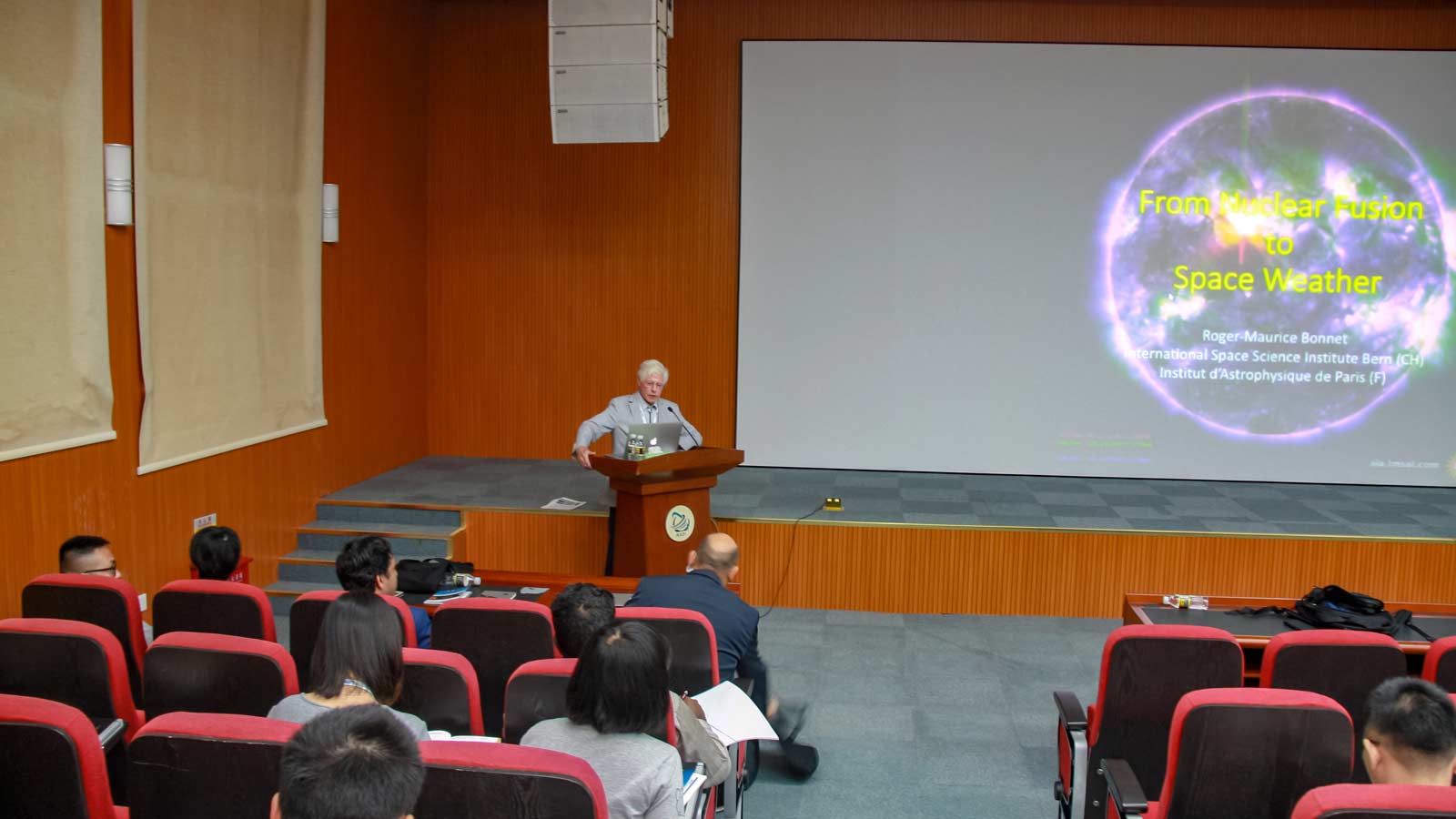Second ISSI-BJ and APSCO Space Science School on "Study Space Weather Effects: From the Sun to the Ground" Successfully Held in China
On October 10-19, 2018, the 2nd ISSI-BJ and APSCO Space Science School with EISCAT on Study Space Weather Effects: From the Sun to the Ground was held at the Sanya Institute of Remote Sensing (RADI) in Sanya, Hainan Province, China. Throughout the school, 10 lecturers and 14 tutors from Asia and beyond shared their knowledge and experience with 57 students from 10 countries.
Group picture of the School Participants
The School started with a short introduction to the school, given by the organizers: Prof. Maurizio Falanga, Executive Director of the International Space Science Institute – Beijing (ISSI-BJ), Dr. Ebrahimi Mohammad Seyedabadi, Director General of the Asia-Pacific Space Cooperation Organization (APSCO), and Dr. Craig J. Heinselman, Director of the EISCAT Scientific Association. The first two and half a day of School were dedicated to introductory lectures about various elements of Space Weather given by the invited speakers, chosen among experts and well-recognized scientists and engineers with an excellent reputation in teaching and supervising participants. The opening lectures revolved around the Sun and its connection to the Space Weather. The first day of School concluded with a Welcome Reception sponsored the Embassy of Switzerland, the country where ISSI-BJ takes its roots from. The School Participants had an occasion to get to know each other while enjoying the colorful buffet in the open air.

Opening lecture given by Prof. Roger Bonnet (Picture Credit: APSCO)
On the following days, experts gave an overview of the Space Weather history, forecasting and SW Science Program of ESA. After the talk on the interplanetary coronal mass ejections, and the lecture on solar energy particles, the following lectures brought the Space Weather topics closer to the Ground. The third day finished with the introduction to students group work, and a social dinner sponsored by ISSI-BJ and APSCO to help the students of each group break the ice. On Saturday afternoon, October 13, the School Participants had an occasion to learn more about the Sanya Institute of Remote Sensing during the technical tour around the campus facilities.
Technical tour around the facilities of RADI (Picture Credit: Xiang Deng)
For the following week, the students were divided into four working groups, depending on their expertise and preferences: Sun/Heliosphere, Impact and Magnetosphere-Ionosphere-Thermosphere Coupling, Ionosphere/EISCAT Incoherent Scatter Radars, and Effects on Satellites and Ground-based Infrastructures. The groups were analyzing in parallel several extreme Space Weather events, such as the ones in September 2017. Each group had its own theme and agenda, using actual observations as well as computer models, and was supported and guided by tutors chosen among the experts in the field.
Students during the group work (Picture Credit: APSCO)
The main task of the working groups during the School was to prepare the presentations of their results, serving as a basis to produce the final reports which will be merged and published after the school has finished. All the groups finished the task with excellence, and presented their outcome on the last day of School.
The School provided the young space researchers and engineers with an opportunity to gain the in-depth knowledge of the science of Space Weather, observational methods and its relevance to applications from the Sun to the ground. The students actively contributed to the School not only with questions and constructive comments after the lectures, but also with an intensive, week-long group work resulting in presentations and reports. During the students’ presentations sessions, young scientists had an occasion to present their research results, and receive invaluable comments and advices from the experts in the field. The final report including the reports written by all the working groups, will be published jointly with APSCO and EISCAT in the TAIKONG ISSI-BJ magazine. This TAIKONG issue will be provided to all the School participants, sponsors, and will be widely distributed to the media.
Students presenting the outcome of their group work (Picture Credit: APSCO)
Apart from the strictly scientific aspect, the School also helped in building links between students and experts from different countries. Young scientists could develop a professional network during coffee breaks and everyday meals, as well as through such events as welcome reception, social dinner, technical tour, and excursion on the free Sunday. It was a wonderful and one of a kind experience to see the space science research and engineering students and lecturers from all over the world brought together, exchanging their ideas also outside of the lecture hall, in the breathtaking surroundings of Sanya. During the closing ceremony, with the lights dimmed, the students had a moment of emotion while watching the video with the most memorable moments of the School. After the big success of the 2nd Space Science School, the third edition is planned in two years, in another member country of APSCO.
2nd Space Science School in Pictures (Video Credit: ISSI-BJ)